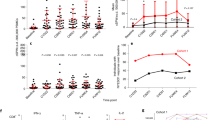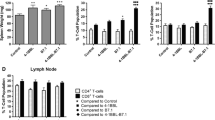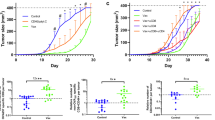Abstract
Toll-like receptor 4 (TLR4) is expressed on dendritic cells (DCs), sensing environmental danger molecules that induce their activation and maturation. Recently, we reported a method for the production of therapeutic DCs against melanoma, called tumor antigen-presenting cells (TAPCells), using a heat-shocked allogeneic melanoma cell lysate (TRIMEL) as an activation factor and antigen provider. Since TRIMEL contains endogenous TLR4 ligands, we evaluated the role of TLR4 in TAPCells differentiation by antibody neutralization and the association of a Tlr4 polymorphism (896A/G) (Asp299Gly), determined by PCR–RFLP, with the in vitro activation capacity and the clinical outcome of TAPCells-vaccinated patients. Antibody blocking of monocyte TLR4 inhibited surface expression, determined by flow cytometry, of the major histocompatibility complex class I, CCR7, CD80, CD83 and CD86 on TAPCells, reduced interleukin (IL)-6 and tumor necrosis factor -α gene expression evaluated by qRT-PCR, and also inhibited the TAPCells-mediated interferon-γ (IFN-γ) secretion of melanoma-specific CD8+ T cells determined by ELISpot (p < 0.01). Moreover, CD8+ T-cell activation capacity was significantly reduced in TAPCells bearing the TLR4 Asp299Gly receptor (p < 0.05). Finally, TAPCells-vaccinated stage-IV melanoma patients bearing the Tlr4 896G allele showed a shortened post-therapy median survival rate compared with those carrying the Tlr4 896A allele (p < 0.05; log-rank test). Our results indicate that TLR4 is a key receptor for the tumor lysate-mediated in vitro generation of clinically efficient antigen-presenting cells. Further analysis of patients included in different vaccine protocols is necessary for definitively establishing a role for TLR4 polymorphism in clinical responses.




Similar content being viewed by others
References
Steinman RM, Banchereau J (2007) Taking dendritic cells into medicine. Nature 449:419–426
Pasare C, Medzhitov R (2005) Toll-like receptors: linking innate and adaptive immunity. Adv Exp Med Biol 560:11–18
Nembrini C, Abel B, Kopf M, Marsland BJ (2006) Strong TCR signaling, TLR ligands, and cytokines redundancies ensure robust development of type 1 effector T cells. J Immunol 176:7180–7188
Iwasaki A, Medzhitov R (2004) Toll-like receptor control of the adaptive immune response. Nat Immunol 5:987–995
Schreibelt G, Tel J, Sliepen KH, Benitez-Ribas D, Figdor CG, Adema GJ, de Vries IJ (2010) Toll-like receptor expression and function in human dendritic cell subsets: implications for dendritic cell-based anti-cancer immunotherapy. Cancer Immunol Immunother 59:1573–1582
Frankenberger B, Schendel DJ (2012) Third generation dendritic cell vaccines for tumor immunotherapy. Eur J Cell Biol 91:53–58
Kanzler H, Barrat FJ, Hessel EM, Coffman RL (2007) Therapeutic targeting of innate immunity with Toll-like receptor agonists and antagonists. Nat Med 13:552–559
Geisse J, Caro I, Lindholm J, Golitz L, Stampone P, Owens M (2004) Imiquimod 5 % cream for the treatment of superficial basal cell carcinoma: results from two phase III, randomized, vehicle-controlled studies. J Am Acad Dermatol 50:722–733
Adams S (2009) Toll-like receptor agonists in cancer therapy. Immunother 1:949–964
Re F, Strominger JL (2001) Toll-like receptor 2 (TLR2) and TLR4 differentially activate human dendritic cells. J Biol Chem 276:37692–37699
Srivastava P (2002) Roles of heat-shock proteins in innate and adaptive immunity. Nat Rev Immunol 2:185–194
Apetoh L, Ghiringhelli F, Tesniere A, Obeid M, Ortiz C, Criollo A et al (2007) Toll-like receptor 4-dependent contribution of the immune system to anticancer chemotherapy and radiotherapy. Nat Med 13:1050–1059
Schröder NWJ, Schumann RR (2005) Single nucleotide polymorphisms of Toll-like receptors and susceptibility to infectious disease. Lancet Infect Dis 5:156–164
Ferwerda B, McCall MB, Alonso S, Giamarellos-Bourboulis EJ, Mouktaroudi M, Izagirre N et al (2007) TLR4 polymorphisms, infectious diseases, and evolutionary pressure during migration of modern humans. Proc Natl Acad Sci USA 104:16645–16650
Santos JL, Lera L, Pérez-Bravo F, Albala C (2006) Adiposity and bone mineral density of Chilean elderly women in relation to toll-like receptor 4 gene polymorphisms. Ann Hum Biol 33:585–592
Arbour NC, Lorenz E, Schutte BC, Zabner J, Kline JN, Jones M et al (2000) TLR4 mutations are associated with endotoxin hyporesponsiveness in humans. Nat Gen 25:187–191
Tal G, Mandelberg A, Dalal I, Cesar K, Somekh E, Tal A et al (2004) Association between common Toll-like receptor 4 mutations and severe respiratory syncytial virus disease. J Infect Dis 189:2057–2063
Santini D, Angeletti S, Ruzzo A, Dicuonzo G, Galluzzo S, Vincenzi B et al (2008) Toll-like receptor 4 Asp299Gly and Thr399Ile polymorphisms in gastric cancer of intestinal and diffuse histotypes. Clin Exp Immunol 154:360–364
Kutikhin AG (2011) Impact of Toll-like receptor 4 polymorphisms on risk of cancer. Hum Immunol 72:193–206
Bergmann C, Bachmann HS, Bankfalvi A, Lotfi R, Pütter C, Wild CA et al (2011) Toll-like receptor 4 single-nucleotide polymorphisms Asp299Gly and Thr399Ile in head and neck squamous cell carcinomas. J Transl Med 9:139
Gast A, Bermejo JL, Claus R, Brandt A, Weires M, Weber A et al (2011) Association of inherited variation in Toll-like receptor genes with malignant melanoma susceptibility and survival. PLoS ONE 6:e24370
Escobar A, López MN, Serrano A, Ramírez M, Pérez C, Aguirre A et al (2005) Dendritic cell immunizations alone or combined with low doses of interleukin-2 induce specific immune responses in melanoma patients. Clin Exp Immunol 142:555–568
López MN, Pereda C, Segal G, Muñoz L, Aguilera R, González FE et al (2009) Prolonged survival of dendritic cell–vaccinated melanoma patients correlates with tumor-specific delayed type IV hypersensitivity response and reduction of tumor growth factor β-expressing T cells. J Clin Oncol 27:945–952
Aguilera R, Saffie C, Tittarelli A, González FE, Ramírez M, Reyes D et al (2011) Heat-shock induction of tumor-derived danger signals mediate rapid monocyte differentiation into clinically effective dendritic cells. Clin Cancer Res 17:2474–2483
Costes SV, Daelemans D, Cho EH, Dobbin Z, Pavlakis G, Lockett S (2004) Automatic and quantitative measurement of protein–protein co localization in live cells. Biophys J 86:3993–4003
Chomczynski P, Mackey K, Drews R, Wilfinger W (1997) DNAzol: a reagent for the rapid isolation of genomic DNA. Biotechniques 22:550–553
Figueroa C, Peralta A, Herrera L, Castro P, Gutiérrez A, Valenzuela J et al (2006) NOD2/CARD15 and Toll-like 4 receptor gene polymorphism in Chilean patients with inflammatory bowel disease. Eur Cytokine Netw 17:125–130
Mendoza-Naranjo A, Sáez PJ, Johansson CC, Ramírez M, Mandakovic D, Pereda C et al (2007) Functional gap junctions facilitate melanoma antigen transfer and cross-presentation between human dendritic cells. J Immunol 178:6949–6957
van der Graaf C, Kullberg BJ, Joosten L, Verver-Jansen T, Jacobs L, Van der Meer JW, Netea MG (2005) Functional consequences of the Asp299Gly Toll-like receptor-4 polymorphism. Cytokine 30:264–268
Andrews DM, Maraskovsky E, Smyth MJ (2008) Cancer vaccines for established cancer: how to make them better? Immunol Rev 222:242–255
Zaloudik J, Vagunda V, Drahokoupilova M, Janakova L, Talac R, Kalabis J, Sheard M (1997) Biomarkers for predicting response to regional chemo-immunotherapy in liver metastases from colorectal carcinoma. Int J Immunopharmacol 19:481–485
Hicklin DJ, Marincola FM, Ferrone S (1999) HLA class I antigen downregulation in human cancers: T-cell immunotherapy revives an old story. Mol Med Today 5:178–186
Ahirwar D, Kesarwani P, Manchanda PK, Mandhani A, Mittal RD (2008) Anti- and proinflammatory cytokine gene polymorphism and genetic predisposition: association with smoking, tumor stage and grade, and bacillus Calmette-Guérin immunotherapy in bladder cancer. Cancer Genet Cytogenet 184:1–8
Jung ID, Jeong SK, Lee CM, Noh KT, Heo DR, Shin YK et al (2011) Enhanced efficacy of therapeutic cancer vaccines produced by co-treatment with Mycobacterium tuberculosis heparin-binding hemagglutinin, a novel TLR4 agonist. Cancer Res 71:2858–2870
Riddell JR, Wang XY, Minderman H, Gollnick SO (2010) Peroxiredoxin 1 stimulates secretion of proinflammatory cytokines by binding to TLR4. J Immunol 184:1022–1030
Yu M, Wang H, Ding A, Golenbock DT, Latz E, Czura CJ et al (2006) HMGB1 signals through toll-like receptor (TLR) 4 and TLR2. Shock 26:174–179
El Mezayen R, El Gazzar M, Seeds MC, McCall CE, Dreskin SC, Nicolls MR (2007) Endogenous signals released from necrotic cells augment inflammatory responses to bacterial endotoxin. Immunol Lett 111:36–44
Casanova JL, Abel L, Quintana-Murci L (2011) Human TLRs and IL-1Rs in host defense: natural insights from evolutionary, epidemiological, and clinical genetics. Annu Rev Immunol 29:447–491
Loeffler J, Ok M, Morton OC, Mezger M, Einsele H (2010) Genetic polymorphisms in the cytokine and chemokine system: their possible importance in allogeneic stem cell transplantation. Curr Top Microbiol Immunol 341:83–96
Weng WK, Czerwinski D, Timmerman J, Hsu FJ, Levy R (2004) Clinical outcome of lymphoma patients after idiotype vaccination is correlated with humoral immune response and immunoglobulin G Fc receptor genotype. J Clin Oncol 22:4717–4724
Ugurel S, Schrama D, Keller G, Schadendorf D, Bröcker EB, Houben R et al (2008) Impact of the CCR5 gene polymorphism on the survival of metastatic melanoma patients receiving immunotherapy. Cancer Immunol Immunother 57:685–691
Tze LE, Horikawa K, Domaschenz H, Howard DR, Roots CM, Rigby RJ et al (2011) CD83 increases MHC II and CD86 on dendritic cells by opposing IL-10–driven MARCH1-mediated ubiquitination and degradation. J Exp Med 208:149–165
Wolchok JD, Hoos A, O’Day S, Weber JS, Hamid O, Lebbé C et al (2009) Guidelines for the evaluation of immune therapy activity in solid tumors: immune-related response criteria. Clin Cancer Res 15:7412–7420
Tesniere A, Schlemmer F, Boige V, Kepp O, Martins I, Ghiringhelli F (2010) Immunogenic death of colon cancer cells treated with oxaliplatin. Oncogene 29:482–491
Baxevanis CN, Perez SA, Papamichail M (2009) Combinatorial treatments including vaccines, chemotherapy and monoclonal antibodies for cancer therapy. Cancer Immunol Immunother 58:317–324
Acknowledgments
This study was supported by grants from the National Fund for Scientific and Technological Development (FONDECYT 1090238, and 1090243), the Fund for the Promotion of Scientific and Technological Development (FONDEF DO5I10366), and the Millennium Science Initiative from the Ministry for the Economy, Development and Tourism (P09/016-F).
Conflict of interest
The authors declare that they have no conflict of interest.
Author information
Authors and Affiliations
Corresponding author
Electronic supplementary material
Below is the link to the electronic supplementary material.
Rights and permissions
About this article
Cite this article
Tittarelli, A., González, F.E., Pereda, C. et al. Toll-like receptor 4 gene polymorphism influences dendritic cell in vitro function and clinical outcomes in vaccinated melanoma patients. Cancer Immunol Immunother 61, 2067–2077 (2012). https://doi.org/10.1007/s00262-012-1268-7
Received:
Accepted:
Published:
Issue Date:
DOI: https://doi.org/10.1007/s00262-012-1268-7




